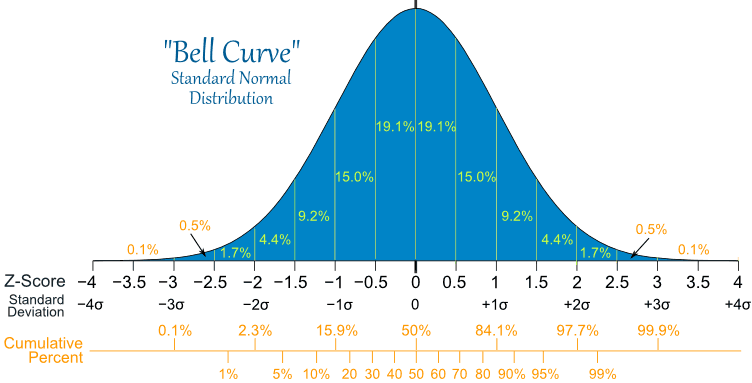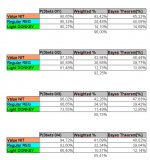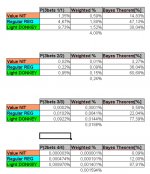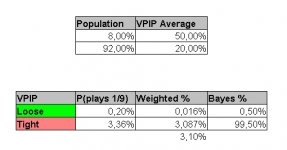dealio96
The LAG Monkeys
Silver Level
Chapter 2 Summary.
1. Variance and Standard Deviation.
Variance describes how far from the EV, you can expect your results to be. It is:
a) Always positive.
b) Additive across n trials:(just like EV).
c) Loose, wild games produce more variance than tight, passive ones.
Standard Deviation is just a square root of Variance:

So for a given n number of hands:whereas

Few Standard Deviations for most popular games (you can actually find those numbers in HM2, probably also in PT4):
View attachment 76365
2. Central Limit Theorem and Normal Distribution.
Central Limit Theorem - the mean of a sufficiently large number of independent random variables, each with finite mean and variance, will be approximately normally distributed.
(So this actually applies perfectly to poker - we have a large number of independent events (hands) and for each one we can calculate EV and V (both are finite).)
Normal Distribution is given by a formula:
&space;=&space;\frac{1}{\sigma&space;\sqrt{2\pi}}e^{-\frac{(x&space;-&space;\mu)^{2}}{2\sigma^{2}}})
(Btw, that is a probability density function so: )a) It doesn't contain negative values (because...probability is always >= 0):
&space;\geqslant&space;0&space;\quad&space;for&space;\quad&space;x\in&space;(-\infty,&space;\infty))
b) The area under the curve is always equal to 1:
dx&space;=&space;1)
Its peak is located at the mean and Standard Deviation influences the width of the curve (well...because by definition Std.Dev describes how far results are from the mean).
Here is how it looks like:- mean (EV)
- standard deviation
- Variance

To calculate the probability of a certain event falling between a and b, we need to calculate the area under the curve for that region. Unfortunately, the integral cannot be solved analytically so we need to do it numerically. Fortunately, it has already been done: formula 2.7 in MoP
I dont want to get into this stuff too much but there is this CDF function which basically answers the question: whats the probability of a certain event a being less or equal to it (so its calculating the probability of: (- infinity; a> ). So if you have 2 events: a and b, what you can do is calculate CDF(a) and CDF(b) and then substract each other and in result you will get the area (which is probability) between both events (thats what the 2.8 formula in MoP really does). In reality, you will usually just calculate a
Z-score (more on this later) and then use a website such as this one:HERE to get what you need
One more thing, we could play a bit with the formula and transform it like this:
&space;=&space;\frac{1}{\sigma&space;\sqrt{2\pi}}e^{-\frac{(x&space;-&space;\mu)^{2}}{2\sigma^{2}}}&space;=&space;\frac{1}{\sigma&space;\sqrt{2\pi}}e^{-\frac{1}{2}{(\frac{x&space;-&space;\mu}{\sigma})^{2}}}&space;=&space;\frac{1}{\sigma&space;\sqrt{2\pi}}e^{(z^{2})^{-\frac{1}{2}}&space;})
Now, the:is the distance from a given x to the mean (EV). If we divide it by , we get that distance in terms of standard deviations. This is actually called a Z-score:
, we get that distance in terms of standard deviations. This is actually called a Z-score:

Z-score – indicates how many standard deviations an observation is above or below the mean (EV).
Example: You are winning at $25/100 hands over a decent sample with a $350/100 Standard Deviation. Whats the Z-score of you breaking even for the next 20k hands?
<EV> = $25/100 * 20000 = $5000
Std. Dev = $350 * sqrt(200) = $4950
Z = (0 – 5000$) / (4950$) ~= -1
This basically means that you are 1 Std.Dev below expectation (EV). You can enter that Z-score into the website, I just posted a link to, or look at the normal distribution graph to get the probability associated with -1 Std.Dev. Either way, its about 15.9%. So if you had 100 samples of 20k hands, you can expect to be break even in 16 of them
(There are some examples in MoP with those type of calculations so I dont know if I have to post more of them. Anyway, they are not really that important, so if you dont understand them (or you dont even want to) just skip them.)
3. Final notes about Variance.
a) Variance is a bi*ch.
b) Variance does not justify bad play.
c) Variance does not only relate to downswings. It also accounts for those upswings/heaters which recreational players love so much.
d) The goal should not be to decrease Variance (???) but to increase Winrate!
(Here is an example in 10NL NLHE showing the effect of increasing WR)
View attachment 76362
View attachment 76363
View attachment 76364
For more, you can check out this website (it has a Variance Simulator): http://pokerdope.com/poker-variance-calculator/
Nice recap, Martin! I've yet to finish chap 2 but feel I'm understanding it for the most part. It's taking me a bit longer than most bc I find myself rereading certain areas that I just can't comprehend. I'm taking your advice though, and making sure I understand how we got there opposed to try and solve every single equation.
This seems like a good chapter for players who have a problem with understanding the expectation of variance throughout large sample sizes.
I'm also wondering If you could break this down and apply it to your own sample and see if you could predict positive/negative variance swings? I mean... It may be a bit more exciting if we can do it in "real life" opposed to looking at it over 200 die rolls. IDK... maybe I'm missing something here... just figured I'd ask.
Just realized you put up a few examples with a variance simulator, Will look into this after awhile. TY sir for all of the hard work you're putting into this!















